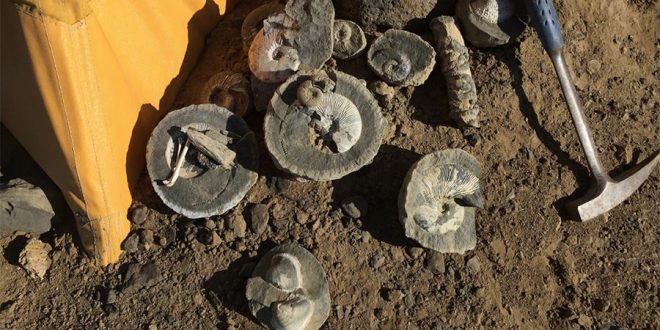A team of international scientists has made a remarkable discovery, unearthing more than a ton of fossils and dinosaur remains in Antarctica. Some of the fossils are believed to be 71 million years old.
UQ School of Biological Sciences researcher Dr Steve Salisbury was one of 12 scientists who travelled to the James Ross Island area in an expedition spanning February and March.
“We found a lot of really great fossils,” Dr Salisbury said.
“The rocks that we were focusing on come from the end of the Age of Dinosaurs, so most of them are between 71 million and 67 million years old.
“They were all shallow marine rocks, so the majority of things we found lived in the ocean.
“We did find a lot of marine reptile remains, so things like plesiosaurs and mosasaurs – a type of marine lizard made famous by the recent film Jurassic World.”
The team found a few dinosaur remains too, which they hope to publish on in the future.
“We also did a lot of good geological mapping while we were there,” Dr Salisbury said.
“We recorded the thickness of all the different rocks and information on the sorts of environments that they represent and how it comes together to create a picture of the environment down there at the time these animals existed.”
The fossils are now in Chile, and will eventually be shipped to the Carnegie Museum of Natural History for further study.
“A lot of the bigger bones will need quite a bit of preparation before we can do much research on them,” Dr Salisbury said.
“It may be a year or two before we get the results out.
“What we found or didn’t find isn’t as important as the fact that we were actually there, trying to do it.
“If that inspires other people to get into the hunt for fossils, then I’ll be very excited.”
The team had to fly to South America and travel by ship to the Antarctic Peninsula, before using helicopters and inflatable boats to get through the sea ice to the shore.
“Crossing the Drake Passage can be kind of rough – some of the biggest seas in the world occur in that area – so most of us just bunkered down for the time we were crossing it,” Dr Salisbury said.
The research team camped out for almost five weeks on Vega Island, often hiking over mountainous terrain for about five kilometres each way to reach their main field site on Sandwich Bluff.
“There were a few days where we did get snowed in, and we’d just be stuck in the communal tent for a while,” Dr Salisbury said.
“I’ve tried to get to Antarctica to do this research several times before, but sea ice has prevented us from making land.
“It was so great to finally get there and have a full blown expedition. It’s a very hard place to work, but it’s an even harder place to get to.
“We found a lot of new ground to continue the search, so we’d all really love to get back down there at some point soon.”
Agencies/Canadajournal
 Canada Journal – News of the World Articles and videos to bring you the biggest Canadian news stories from across the country every day
Canada Journal – News of the World Articles and videos to bring you the biggest Canadian news stories from across the country every day




Funny, 71 million years old yet buried, as are 99.9% of all the worlds trillions of fossils by Noah’s flood. Strange that they never ask themselves why fossils are not being made today except in some small localized flooding. Just as fascinating is the millions upon millions of fossils of tropical animals in the arctic. Another verification of the Bibles claims of a completely different world before the worldwide flood. A world that modern science cannot account for. A world without rain and snow or cold regions and filled with tropical animals. Yet the Bible and the raw data in the form of fossils says that world exisited.